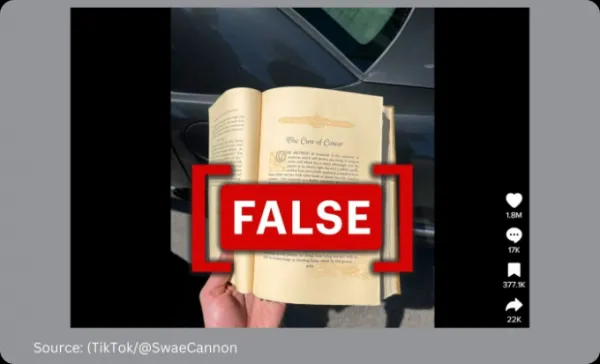By: Christian Haag
June 21 2023
No, escharotic treatments do not cure cancer

The Verdict False
There is no evidence escharotic treatments cure cancer. Unregulated use has resulted in scars and tissue damage due to its corrosive nature.
Context
Claims about a secret book containing the cure for cancer have recently been made on TikTok. The book, titled Cancer: Its Proper Treatments and Cure - Escharotic Treatments, was written by Perry Nichols MD in 1937 and purports to contain the cure for cancer using an escharotic treatment. The treatment involves applying a special salve to cancerous tumors or lesions to destroy any living or “fungous” tissue. The book claims this corrosive substance is able to kill cancer within a few hours and contains pages of names of people it claims to have cured.
On TikTok, one video gained 3.8 million views and 1.8 million likes, and another reached 18.4 million views and 1.9 million likes. The accounts making these claims express fear of government repression for “leaking” the book and bringing the secrets to the public
In Fact
An escharotic treatment, more commonly known as “black salve” or “cansamera” is a corrosive paste primarily made up of bloodroot (sanguinaria canadensis) and zinc chloride. It is commonly claimed to selectively kill cancer cells and preserve healthy ones.
Escharotic is derived from “eschar,” a dry, black scab formed after a burn. The salve burns away skin tissue indiscriminately, and cases of injury and scarring have been reported due to the substance's corrosive nature. DermNet lists several dangers associated with escharotic salves, such as its failure to remove tumors altogether, cancer returning, lesions that remain undiagnosed, and an unregulated market and manufacturing. Dermnet notes there is no substantial scientific evidence of the safety or efficacy of escharotic agents. Both FDA and Quackwatch warn of the dangers of this treatment.
It should be noted that the same substances were used to develop modern skin cancer treatment. Today, Mohs micrographic surgery is used to treat most superficial skin cancers. Fredrich Moh (1910-2002) developed a method in 1932 in which he used a formula of zinc-chloride paste with bloodroot. The formula would “fix” the malignant tissue in place but preserve the cellular structure. He would then excise a thin layer of tissue and, using a microscope, assess the extent of the cancerous tissue. He would remove the tissues, reportedly leaving the patient cancer free. The method was modified, and in 1953 he developed the “fresh tissue method”, which used less zinc chloride. It has since been continuously reiterated. Today, the method has a very high success rate, though it no longer includes zinc chloride.
Perry Nichols (1863-1925), a contemporary of Moh, ran several facilities treating skin cancer. The largest facility was in Savannah, MO, and closed in 1956. He used a similar escharotic formula to Moh and is said to have treated 70,000 patients. The book seen in the video is a yearbook from the Nichols Sanatorium, which is available to buy from auction websites. Nichols' method differed from Moh's, as he did not believe in pathology and did not use microscopic control. As such, his visual method could not account for microscopic tumor cells. Nichols did use a method similar to Moh 36 years before him but never realized the use of microscopic control or pathological examination.
Verdict
Considering the health hazards of using unregulated escharotic treatments such as black salve and bloodroot paste, their failure in curing cancer, and since the methods of this treatment are not secret, we have marked this claim as false.


